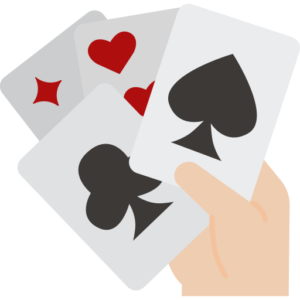Glossary Term
Calling Station
Calling Station
Used In: Poker
Introduction
A calling station in poker is a player who frequently calls bets but rarely raises. They are not aggressive and tend to play passively, often staying in hands with weaker cards. This behavior makes them easy to identify, as they don't bluff or make bold moves. Instead, they prefer to see more cards and hope their hand improves. Because they call often, they can inflate the pot, which may seem dangerous if you’re not prepared to play strong hands.
The key to beating a calling station is patience and discipline. You can often win by betting aggressively when you have a strong hand and not overcommitting when your hand is weak. The most important thing when facing a calling station is to focus on value betting and not trying to bluff them out of pots.
The most important thing when facing a calling station is to focus on value betting and not trying to bluff them out of pots.
In Depth Look
A calling station in poker is a player who prefers to call bets rather than raise or fold. They often play hands passively, sticking around to see more cards even when their hand isn’t strong. This type of player doesn’t typically make bluffs, so their decisions are easy to predict. Because of this, they often lose value by not raising with strong hands and only calling when they should be folding or betting. However, they can also be tricky because they are unpredictable in the sense that they rarely fold, which can lead to larger pots when they unexpectedly hit a strong hand.
Playing against a calling station requires a different approach than facing more aggressive players. The best strategy is to make value bets when you have a strong hand, as a calling station will likely stick around and pay you off. However, you should avoid bluffing, as they are less likely to fold. The most effective way to beat a calling station is to be patient and consistently make solid bets when you have a good hand, allowing their passivity to work in your favor.
Mechanics
A calling station’s mechanics are centered around a passive style of play. Instead of raising or folding, they mostly call bets, often staying in the hand with a wide range of starting hands. They don’t aggressively seek to take control of the pot, even when they have a good chance of winning. Their decision-making process is simple: if they believe the price to see the next card is worth it, they will call. This can lead to them staying in pots with weak hands, increasing their chances of getting lucky if the board improves. Because of their frequent calls, they often become a constant presence at the table, making them predictable but hard to shake off.
On the other hand, the mechanics of a calling station also make them vulnerable to experienced players. Since they rarely raise, they don’t create pressure on opponents to make tough decisions. This allows players who are able to read their behavior to play more aggressively when they have strong hands. The calling station’s reluctance to fold means they can inflate pots when they hit strong hands, but they also lose large pots when they stay in with weak hands. Understanding how a calling station plays and adjusting accordingly, such as betting for value and avoiding bluffs, is key to managing their passive but often costly approach.


Illustrated Example
Imagine you’re playing a no-limit Texas Hold'em game. You’re in the small blind with A♠ K♣. The player in the big blind is a clear calling station. Pre-flop, the player calls a standard raise of 3x the big blind. The flop comes Q♠ 9♦ 2♣, giving you a top pair with a strong kicker. You bet about half the pot, hoping to get value. The calling station calls without hesitation. The turn brings the 5♠, which doesn’t change much. You bet again, but the calling station calls again. On the river, the 8♠ completes the board, giving you the A♠ for top pair and a potential straight draw. You bet a large amount, and the calling station calls, even though their hand is much weaker than yours. In the end, they pay you off with a weaker hand, even though you had the stronger one all along.
In this example, the calling station’s lack of aggression and their tendency to call with weaker hands leads to them losing a big pot. They didn't raise when they had a good chance to, and they stuck around even though the odds were against them. They made predictable decisions, allowing you to extract value from them. Here’s a table showing key behaviors of a calling station:
Player Perspective
A1 calling station can be both frustrating and profitable. They rarely fold, even when their hand is weak, which can lead to larger pots. However, since they don’t raise much, it’s easy to control the action and bet for value when you have a strong hand. You don’t need to worry about them bluffing or applying pressure, so you can focus on playing solid poker and extracting value from their tendency to call.
On the downside, a calling station can be hard to shake off once they’ve entered a pot. They’ll often stick around even if the odds aren’t in their favor, which can lead to surprises if they hit a lucky draw. The key is to remain patient and avoid trying to bluff them. Instead, focus on betting for value, knowing they’ll likely call with a weaker hand.
Conclusion
In the end, a calling station is a predictable player who sticks around with weak hands and rarely raises. While this can make them easy to read, it also gives you a chance to win big pots when you have a strong hand. The best way to handle a calling station is to bet for value and avoid bluffing. Patience is key—wait for good hands and let them pay you off with their passive play.
The Top Online Casinos for Playing Poker
These platforms prioritize player satisfaction by providing intuitive interfaces, seamless gameplay experiences, and robust security measures to ensure a fair and enjoyable environment for all users.


Author
Branimir Ivanov | Senior News Contributor







